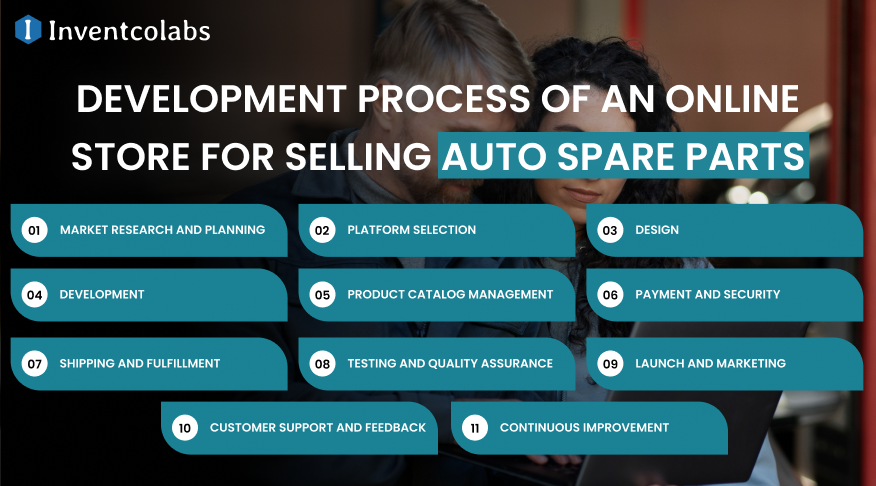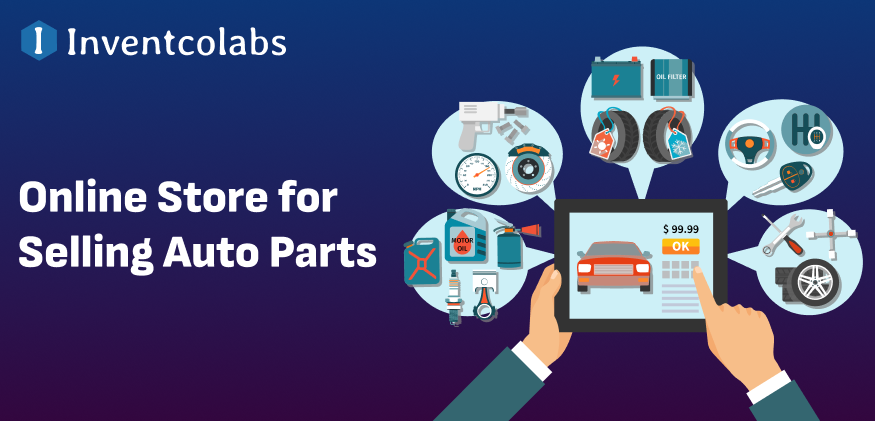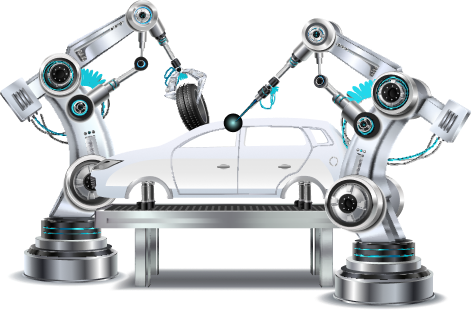With the advent of the digital era, a dramatic change has been observed in the automobile industry towards an online store for selling auto parts. This guide on developing an auto parts online store addresses the most important aspects, from understanding the market to the development process and cost estimates.
What are Auto Spare Parts?
Auto spare parts are the components to fix damaged or worn-out components on a vehicle in which they operate. Such components embrace products like engine parts, electric equipment, body components, and accessories to accommodate different vehicle brands and types.
Monetization Opportunities For An Auto Parts Online Store
E-commerce auto parts websites can be monetized in many ways, which include direct sales of products, affiliate partnerships with manufacturers or suppliers, or selling installation guides that charge a fee. Utilizing these paths could increase revenue possibilities for the auto spare parts online store. Selling auto parts online is entirely under your control. You may set your prices for your products and won’t have to worry about fees added to every transaction, unlike with eBay and Amazon.
- Because it balances time investment and revenue potential, affiliate marketing is the ideal monetization strategy for automotive platforms. It is the best place to sell car parts online.
- Display advertisements provide the second-best revenue stream for an automotive shop. Choose the appropriate ad network to sign up for, as traffic needs may vary among these networks. As soon as an ad network accepts you, include their advertisements on your website by following their integration instructions.
- Trading your knowledge and time for a price is what consulting or coaching entails. You have demonstrated yourself to be the expert that your customers require. People will start to approach you with inquiries on subjects they think you are an authority on as you establish yourself as one in the field. You can earn from these consultant services.
Read more: How to Develop A Ride-Sharing App? Key Features & Cost
Key Benefits Of Developing Best E-commerce Platform For Auto Spare Parts
E-commerce platform is an easy model for auto spare parts that can provide a lot of advantages to businesses and even customers.

Wider Market Reach:
It is also true that an e-commerce platform enables auto spare parts businesses to attract clients outside their geographical boundaries. They can attract customers from various zones not only nationally, but also at a global scale, and that allows them to access a larger automotive marketplace.
Increased Sales:
By investing in a well-organized e-commerce site, companies will be capable of promoting their whole range of products effectively. It can lead to better visibility as the customer base among internet users is much wider. Eventually, it may result in increased revenue. This is because customers can freely browse through a variety of auto-spare products and also purchase conveniently directly from their online source.
Cost Savings:
All things considered, selling car parts online and running an e-commerce platform can be more cost-efficient than keeping a physical store. Business establishments do away with costs like rent or utilities and staff, which optimizes the profit margin ratio.
Personalized Shopping Experience:
E-commerce systems can provide personalized shopping facilities that include user accounts as well as keep a record of the purchase history. Based on the historical purchasing patterns of a customer, businesses can suggest other suitable products which in turn creates more engagement and loyalty.
Scalability:
One of the key characteristics that define an auto parts e-commerce website development is its ability to scale. It can handle more and bigger volumes of traffic and sales as the business expands. The scalability of this platform ensures that it can evolve alongside the ever-changing demands of the business and handle future growth plans efficiently.
Characteristics Of a Successful Online Auto part E-commerce Store
E-commerce stores for auto parts are popular among customers and generate good revenue for businesses. They are distinguished by several features that prioritize customer convenience and significantly contribute to driving overall sales performance.

User-Friendly Interface:
There should be a simple and user-friendly automotive software design to the website. Customers can find products with ease, perform searches efficiently as well as complete orders effortlessly. Such clearness is vitally important for proper categorization and search performances that help customers find the auto parts they need.
Mobile Responsiveness:
As the trend of shopping on mobile devices continues to rise, therefore it is necessary to optimize mobile responsiveness. This provides a positive user experience across a broad range of devices, as the website appears correctly and runs smoothly on smartphones and tablets.
Customer Reviews and Ratings:
It can help users feel credible and trustworthy by using customer reviews or ratings for the auto parts standards. This has further given social proof of the quality of products and customer satisfaction, which motivates consumers to purchase products.
Effective Order Fulfillment:
When it comes to fulfilling orders, having adequate stock, and processing orders quickly are two factors that lead to the success of an e-commerce store. Accurate information concerning the ordering process and timely delivery of spare parts contribute to client satisfaction.
Discounts and Promotions:
By using special offers, discounts, and price reductions on automobile components, you can lure away customers from competitors. Promotional strategies like discount codes, bundle offers, or free shipping promotions can then be put in place to build a higher turnover for the firm.
Explore more: How To Create An On-Demand Roadside Assistance Mobile App?
Development Process of An Online Store For Selling Auto Spare Parts:
Here are the key steps that define the development process of an online store for selling auto spare parts:

Market Research and Planning
- Define your audience and determine what their needs are and how you can fulfill them.
- Align with the auto spare parts industry by conducting research on competitors and discovering market trends.
- Describe your unique propositions for selling car parts online as well as business objectives.
- Focus on the full-fledged business plan that encompasses your e-commerce store’s goals, the target audience, and marketing activities including promotional tools and costs; besides finances.
Platform Selection
- From the shopping responsibility plan, choose a store that creates content. Among the most popular versions of these e-commerce platforms are Shopify, WooCommerce, Magento, BigCommerce, and custom design.
- Scalability, ease of customization, and user-friendliness are other factors that should be included.
Design
- Craft a user-friendly web layout design with the help of an automotive parts website builder. The design should portray your brand image and meet the needs of its target audience.
- Optimize the design by making it responsive for all platforms without compromising the viewing experience and functionality of the website on each device’s screen size (desktop, laptop, smartphone, tablet).
Development
- Hire dedicated developers and create relevant features including product catalog, search functionality, shopping cart, checkout process, registration, and account management.
- By having secure payment gateways and SSL encryption, online transactions will be safe.
- To further enhance functionality incorporate third parties, like inventory management, order fulfillment, shipping, and customer support.
Product Catalog Management
- Systematize your auto spare parts inventory in terms of product type, make, model, and compatibility to facilitate better management.
- Quality product listings should be enhanced for organizations with detailed descriptions, specifications, images, and pricing of their products.
- Make it possible for the customers to sort and filter various options to help them locate a part.
Payment and Security
- Create secure payment gateways to enable different modes of payment, such as credit/ debit cards, PayPal, and other online payment mechanisms.
- Ensure responsible adherence to PCI- DSS to guard customers’ payment information and ensure data security.
Shipping and Fulfillment
- Specify shipping selections (such as standard, or expedited) and rates based on the weight or dimensions of items and delivery location.
- Implement API of shipping carriers to dynamically compute the rate applicable for shipping and that offer tracking information.
- Establish order management systems to allow for efficient order processing, be it inventory updates or shipping logistics.
Testing and Quality Assurance
- Carry out rigorous checks on the site’s functionality, user experience, and performance across varying browsers and devices.
- Testing behaviors like product search, navigation, checkout flow, payment processing as well as order fulfillment to guarantee the best possible user service.
- After thorough testing and debugging, identify the bugs, errors, or any usability issues that could be rectified. App development for selling spare parts will be mostly done here.
Launch and Marketing
- Determine when to launch your automobile parts online store and plan the promotion strategies that will attract customers.
- Utilize SEO techniques to make your automotive e-commerce website more visible to search engines so that organic traffic can arrive at the site.
Customer Support and Feedback
- Maintain several customer support channels, such as email support, live chat, and phone service for inquiries and to help solve issues or provide aid with them.
- Utilize reviews, ratings, and feedback surveys to gain insights into the improvement of your products and services consistently.
- Incorporate a receptive customer complaints management program that will respond quickly to customer grievances and preserve a favorable reputation.
Continuous Improvement
- In addition, update your product catalog regularly with new auto spares and accessories that run according to market demands and customer response.
- Keep an eye on the performance of your site, analyze user behavior, and collect customer feedback to find out where you can improve modifications.
- Stay updated with software development for automotive industry trends, emerging technologies, and e-commerce standards to be competitive and prepared for developing customer dynamics.
Approaches To Develop An Auto Spare Parts’ E-commerce Store
The e-commerce store for selling auto parts can be created through custom development platforms like Shopify and WooCommerce, or by working with outsourcing service providers.
- Custom development is highly targeted and appropriate, but it takes little time to build new products because it requires technical knowledge.
- An e-commerce website for automotive parts offers predefined constructive products for automotive parts, which can be customized to reduce deployment time.
- While outsourcing development provides knowledge in areas of specific skills, communication and management abilities still need to be clear.
Explore more: Automotive Software Development Guide – Cost & Features
Components of the Auto Spare Parts App Development Panel
The development panel for an auto spare parts app generally has some components and functionalities necessary in terms of designing, developing, testing, and deployment of the application.

Project Management Tools:
It allows team members to communicate, collaborate, and organize.
- Task management
- Team collaboration features
- Scheduling and time tracking
Development Environment:
It contains the tools and resources required for coding, testing, bug fixing as well as deploying the application.
- IDE (Integrated Development Environment or code editor)
- Debugging tools
- Code libraries and frameworks
UI/UX Design Tools:
These tools support the app environment by setting a context for them to operate.
- Wireframing and prototyping tools
- Graphic design software
- User flow diagrams
- Design collaboration platforms
Backend Development Components:
The functions of the backend development components on a server lie in their ability to process logic, and databases, and provide successful API integrations.
- Server-side Programming Languages such as node js, Python, and Java Technology.
- There are web frameworks such as Express.js, Django, Spring Boot, etc.
- Different Database management systems (for example, MongoDB, MySQL, PostgreSQL)
Frontend Development Components:
Frontend development units deal with client-side creation of the interface of apps.
- HTML, CSS, and JavaScript Frameworks (E.g., ReactJs, Angular, or Vuejs.)
- Responsive design Frameworks (e.g., Bootstrap, Foundation).
- Cross-browser testing tools
Quality Assurance Tools:
QA tools enable testing and debugging during which the quality, functionality, and performance of the application are inspected.
- Automated testing tools: Selenium Jest and Cypress
- Performance testing tools
- Bug tracking and issue management tools
Deployment and DevOps Components:
With the help of this feature, the app is deployed and monitored in production using various techniques.
- Deployment automation tools (such as Jenkins and Travis CI),
- Tools for both containerization and orchestration (e.g., Docker, Kubernetes).
- Monitoring and logging tools
Documentation and Collaboration Tools:
These tools are designed to generate documents and exchange data on one or more projects, as well as improve cooperation among members of the project team
- Online document platforms (such as Confluence or GitHub Wiki)
- Communication tools like Slack and Microsoft Teams.
- Virtual Meeting and Screen-Sharing tools
Cost To Develop An Auto Parts E-commerce Store
The cost of developing an auto parts e-commerce store depends on factors such as platform selection, integrated features, and customizations. It is necessary to plan accordingly and consider features according to the business goals and customer requirements. The startup cost of opening an auto parts online store can be anywhere between $5,000 and $10,000 or higher depending on the factors discussed above. To get an exact price and make sure that the website meets your needs and objectives, you will have to contact an experienced and reliable automotive software development company.
Conclusion
The emergence of the automotive aftermarket industry provides ample opportunities for establishing an e-commerce store where auto spare parts can be sold over the Internet. With the proper understanding of the fleet management software development market, use of an appropriate e-commerce platform, and concentration on major developmental parameters, it is possible for businesses to ensure that they have a good online presence and can cater to the diversified needs of automotive enthusiasts globally.
FAQs
Q. How do I select a proper e-commerce selling platform for auto spare parts?
ANS. Focus on flexibility, scalability, customization, security, technical support, and integration features when selecting an e-commerce auto spare parts selling platform.
Q. What characteristics should the auto parts e-commerce store have and which are most important?
ANS. Characteristics of auto parts e-commerce stores include product descriptions, comprehensive search functionalities, secure payment channels, mobile friendliness, inventory and order management for sellers, and account provisions to customers.
Q. What measures can I take to secure online transactions on my auto parts store?
ANS. Communicate with the customers and encourage them to use secure payment gateways, and SSL encryption, upgrade their software regularly, implement two-factor authentication measures, and teach appropriate internet behavior.
Q. What marketing tactics will be more suitable for promoting an auto parts e-commerce store?
ANS. Apply SEO, content marketing, social media, email campaigns, influencer partnerships as well as audience engagement to sell automobile parts online.
Q. How can I monitor my product amount in an e-commerce online store?
ANS. Adjust the current catalog for new, updated, or discontinued products and implement auto-order operations for continuous monitoring of the product amount.





